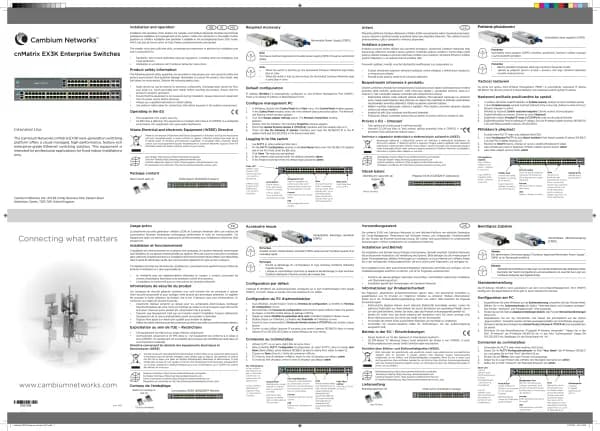Cambium Networks XMS Cloud handleiding
Handleiding
Je bekijkt pagina 7 van 90

e. Allowed VID values (8 max)/Allowed VLAN Overrides: This setting is only used for trunk ports.
Specify the VLANs to be handled on this trunk port. The VLANs must all have been previously
defined.
3. Authentication: For devices connecting to the XR-320 switch ports, the following authentication
options areavailable.This setting applies globally to all four switch ports.
l Open: This option provides no authentication.
l RADIUS MAC: Uses an external RADIUS server to authenticate devices onto thewirednetwork,
based on the connecting device’s MAC address. If you select this option, specify a primary and
optional secondary RADIUS server. You may specify each server using a host name or IP address.
Change the port if needed, and enter the shared secret needed to access each server.
l VLAN Support — VLAN supports your networks Virtual LANs and allows this profile’s APs to support them as
well. This allows VLANs to be specified elsewhere in the profile—for SSIDs, Bonjour Director, and Policies.
n Dynamic VLANs — If you are using RADIUS for client authentication and RADIUS is dynamically assigning
VLANs to clients, create a list of all the VLANs that may be assigned by the RADIUS server. Enter each
VLAN and click ADD. If the network does not use dynamic VLANs, this list is not needed.
l Active Directory Configuration for Access Points
You can perform 802.1x user authentication on your wireless network based on user accounts in
an Active Directory server or a RADIUS server (see SSIDs below). If you are using Active
Directory, set this to Yes and fill in the fields that are displayed.
You may want to try out the configuration on one AP first and make sure that it works before
adding the rest of the APs to this profile. In case of problems, note that the CLI and Web
Management Interface on APs both include special test commands to assist with validating
proper communication between the Active Directory server and the AP.
Enter the following settings in the XMS-Cloud profile.
n Domain Administrator/Password: Enter the administrator account name and password for access to the
domain controller. An Access Point will use these to create a machine account on the domain for the
Access Point. This can be the name of any account that can join a machine to the domain.
n Domain Controller: Enter the hostname to access the domain controller. This must be a fully qualified
domain name (FQDN). This cannot be entered as an IP address.
n Workgroup/Domain: Enter the Pre-Windows 2000 Domain name. This can be found by opening the Active
Directory Users and Computers. Right click the domain in the left hand window and select Properties. This
will display the Domain name that should be entered.
n Realm: Realm name (may be the same as the domain name). Workgroup and Realm are both required. To
find the Realm, open a command window on a domain workstation and type: echo %userdnsdomain%. This
will display the Realm.
You must also enter the following settings:
n In Access Points, set up Encryption/Authentication settings for the desired SSIDs to use the Active
Directory for authentication.
l RSTP - Enabling Rapid Spanning Tree Protocol (RSTP) is a network protocol that ensures a loop-free topology
for Ethernet networks.
l Radius Settings for Switch
You can set the Radius Settings for Switch by set this to Yes and fill in the fields that are displayed.
n Host IP: Enter the Host IP address.
n Shared Secret: Enter the valid Shared Secret key.
n Confirm Shared Secret: Confirm the Shared Secret key.
7 | Help Guide | XMS Cloud
Bekijk gratis de handleiding van Cambium Networks XMS Cloud, stel vragen en lees de antwoorden op veelvoorkomende problemen, of gebruik onze assistent om sneller informatie in de handleiding te vinden of uitleg te krijgen over specifieke functies.
Productinformatie
| Merk | Cambium Networks |
| Model | XMS Cloud |
| Categorie | Niet gecategoriseerd |
| Taal | Nederlands |
| Grootte | 13480 MB |







